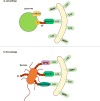Cargo recognition and degradation by selective autophagy
- PMID: 29476151
- PMCID: PMC6028034
- DOI: 10.1038/s41556-018-0037-z
Cargo recognition and degradation by selective autophagy
Erratum in
-
Author Correction: Cargo recognition and degradation by selective autophagy.Nat Cell Biol. 2023 Jul;25(7):1073. doi: 10.1038/s41556-023-01177-x. Nat Cell Biol. 2023. PMID: 37286635 No abstract available.
Abstract
Macroautophagy, initially described as a non-selective nutrient recycling process, is essential for the removal of multiple cellular components. In the past three decades, selective autophagy has been characterized as a highly regulated and specific degradation pathway for removal of unwanted cytosolic components and damaged and/or superfluous organelles. Here, we discuss different types of selective autophagy, emphasizing the role of ligand receptors and scaffold proteins in providing cargo specificity, and highlight unanswered questions in the field.
Conflict of interest statement
The authors declare no competing financial interests.
Figures



References
Publication types
MeSH terms
Substances
Grants and funding
LinkOut - more resources
Full Text Sources
Other Literature Sources
Miscellaneous

